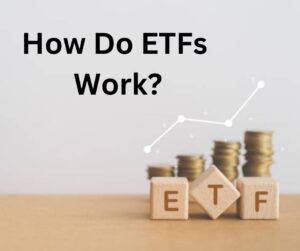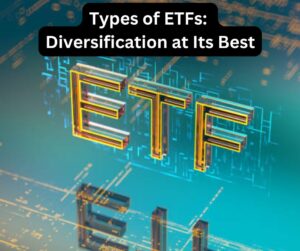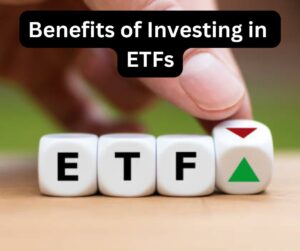
What Are ETFs in the Share Market?
Think of an ETF (Exchange-Traded Fund) like a basket that holds different types of investments, such as stocks, bonds, or commodities.
When you buy a share of an ETF, it’s like buying a small piece of that entire basket.
This makes it different from buying shares of just one company.
For example, if you want to invest in the tech sector but don’t want to put all your money into a single company like Apple or Google, you can buy an ETF that tracks a group of technology companies.
How Do ETFs Work?

ETFs are similar to mutual funds because they pool together money from many investors to buy a diversified set of assets.
But unlike mutual funds, which are typically traded only once a day, ETFs can be bought and sold on stock exchanges throughout the day, just like regular shares of a company.
This means you can trade ETFs whenever the stock market is open, giving you more flexibility.
Let’s use a simpler analogy: imagine an ETF as a “fruit basket” that you can buy at a supermarket.
This fruit basket (the ETF) contains a variety of fruits (stocks, bonds, etc.).
When you buy a share of this fruit basket, you’re getting a bit of each fruit inside it.
If one fruit (like an apple) isn’t doing well, maybe the orange or banana will balance it out.
This way, you don’t put all your money into just one type of fruit and instead enjoy a mix, which reduces your risk.
Types of ETFs: Diversification at Its Best

ETFs come in different types, each designed to meet specific investment goals.
Here are a few common types:
1. Equity ETFs:
These ETFs invest in stocks.
For instance, a Nifty 50 ETF in India would invest in the top 50 companies listed on the NSE (National Stock Exchange).
This means, by buying one share of a Nifty 50 ETF, you get exposure to all 50 companies in the index.
2. Bond ETFs:
These focus on bonds and are generally considered safer than equity ETFs.
They can be a good option for those seeking regular income with lower risk.
For example, a Government Bond ETF could include bonds issued by the Indian government, providing a more stable investment.
3. Sectoral ETFs:
These target specific sectors like technology, pharmaceuticals, or banking. If you believe that the banking sector is set to perform well, you could buy a Banking ETF that includes shares of top banks like HDFC Bank, ICICI Bank, and State Bank of India.
4. Gold ETFs:
These ETFs allow you to invest in gold without actually owning physical gold.
For example, instead of buying gold jewelry or coins, you can invest in a Gold ETF that tracks the price of gold.
It’s a simple and convenient way to gain exposure to gold.
Real-Time Example: Understanding ETFs with a Cup of Tea
Let’s say you want to make a cup of tea but don’t want to buy all the ingredients separately—tea leaves, sugar, milk, and spices.
Instead, you go to a store and buy a “tea mix” that has everything you need in the right proportions.
This tea mix is like an ETF.
Instead of buying individual ingredients (stocks), you’re buying a pre-packaged mix (ETF) that has everything included.
Now, imagine a Nifty 50 ETF.
It’s like a tea mix that has ingredients from India’s top 50 companies, such as Reliance Industries, Infosys, TCS, and HDFC Bank.
If Reliance (one of the tea leaves) doesn’t do well, maybe Infosys (another tea leaf) balances out the flavor, so your tea still tastes good.
This way, you benefit from the overall performance of the top 50 companies without having to buy each stock separately.
Benefits of Investing in ETFs

1. Diversification:
With one investment in an ETF, you get exposure to multiple stocks or bonds.
This spreads your risk and can provide more stability to your investment portfolio.
If one stock in the ETF performs poorly, the other stocks can help offset the losses.
2. Low Costs:
ETFs generally have lower expense ratios compared to mutual funds.
This means that the annual management fees you pay to the fund manager are lower, allowing you to keep more of your returns.
3. Liquidity and Flexibility:
Because ETFs trade like stocks on an exchange, you can buy and sell them anytime during market hours.
This liquidity gives you flexibility and control over your investments.
Real-Time Example: Investing in a Gold ETF
Let’s say you want to invest ₹10,000 in gold but don’t want to deal with the hassle of storing physical gold.
Instead, you invest in a Gold ETF listed on the NSE.
If the price of gold goes up by 10%, the value of your Gold ETF investment would also go up by a similar percentage.
You can buy or sell the Gold ETF during market hours, just like you would with stocks, making it an easy way to invest in gold.
For instance, imagine you invested ₹10,000 in a Gold ETF when gold was priced at ₹5,000 per gram.
If gold prices rise to ₹5,500 per gram, your ETF investment would see a similar increase, giving you a profit without needing to worry about storing or securing physical gold.
Are ETFs Right for You?

ETFs are a great choice for both beginners and experienced investors.
They allow new investors to gain exposure to a diversified portfolio with a single purchase, making it simpler than choosing individual stocks.
Meanwhile, experienced investors can use ETFs to target specific sectors or balance their portfolios easily.
However, like any investment, ETFs come with some risks.
The value of an ETF can fluctuate based on the underlying assets it holds, and investors should be aware of market trends.
But with the right research and a clear understanding of your investment goals, ETFs can be an excellent tool for building wealth over time.

Thanks I have just been looking for information about this subject for a long time and yours is the best Ive discovered till now However what in regards to the bottom line Are you certain in regards to the supply
I do believe all the ideas youve presented for your post They are really convincing and will certainly work Nonetheless the posts are too short for novices May just you please lengthen them a little from subsequent time Thanks for the post